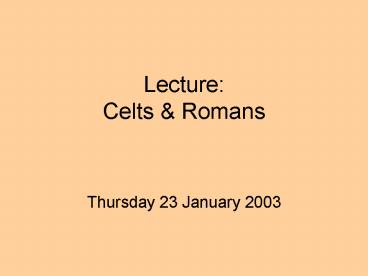Lecture: Celts PowerPoint PPT Presentation
1 / 19
Title: Lecture: Celts
1
LectureCelts Romans
- Thursday 23 January 2003
2
Key Terms
- Celts
- Gauls
- Druids
- hexagon (modern term geometrical shape of what
is now France)
3
Timeline (review)
- 40, 000 BCE Homo sapiens sapiens
- 40,000-6000 BCE OLD STONE AGE.
- Humans shaped by environment.
- 16,000-14,000 BCE Lascaux cave art
- 10,000-9,000 BCE Warming period
- Receding glaciers, rising water levels.
- 8,000 BCE Bow appears. Dogs domesticated.
- 6,000-1,800 BCE NEW STONE AGE (NEOLITHIC PERIOD).
- Gradual shift from hunting-gathering to settled
farming. Edible plants, cultivation, herding.
Tool-making, pottery. Humans shape environment. - 1,800-700 BCE BRONZE AGE
- 700-100 BCE IRON AGE
4
Timeline (continuation)
- 6,000-1,800 BCE NEW STONE AGE (NEOLITHIC PERIOD).
Shift hunting-gathering to farming. - 3,500-1,800 Megalithic monuments (northwest
coast). SOM culture (north). - Bell Beaker culture (Alps).
- 2,000 Indo-European languages established
(outside the hexagon). - 1,800-700 BCE BRONZE AGE.
- 1,400 Metal spreads throughout hexagon.
- 1,250-200s Metalworking spread by urn-field
burial peoples. - 700-100 BCE IRON AGE.
- 700s 400 CELTS arrive (migration /
invasion). Bring Indo-European languages. - 600 MASSALIA (Greek trading colony now
Marseille) established. - 100 BCE-476 CE ROMANS arrive in hexagon.
- 125-121 Rome called to protect Massalia. Result
Roman control of south coast. - 58-51 Caesars conquest of Gaul.
- 52 Battle at Alésia. Caesar defeats
Vercingetorix.
5
Celtic contributions to hexagon life (700 BCE
through Roman era)
- NEW TECHNOLOGIES Iron plows, sickles, reapers,
swords. Horsemanship. - PRIMARY OCCUPATIONS Farmers and warriors.
- SOCIO-ECONOMIC ORGANIZATION Landed aristocracy
(estates, large open fields, tenant farmers). - SOCIO-POLITICAL ORGANIZATION Tribes subtribes,
characterized by shaky alliances, discord. - RELIGION Polytheistic (many gods). Druids
(priests). - LANGUAGES Indo-European.
6
Celts Gauls A group of peoples. Not a nation,
not a unified culture.
- Their agricultural achievements contributed to
population growth. - Their tribes politics and customs shaped the
subsequent history of local regional life. - Romans called them Gauls.
- Caesar observed that the Gauls were divided by
language, customs and laws. - There was NO nation of Celts. Gaul was NOT a
country.
7
Massalia (established 600 BCE)
- Site of present-day Marseille.
- Founded by the Greeks.
- Hub of trading network throughout hexagon.
- Trade broadened from tin to include copper, iron,
glassware, leather goods, cereals, salt, slaves,
cured meats. - This trade contributed to an urban network
covering most of the hexagon. - Allied with Rome.
8
Celts Romans
characters from Asterix comic books
9
some Roman contributions to life in Gaul (58
BCE 476 CE)
- taxes
- military conscription
- coinage
- markets
- administrative officials
- soldiers
- language
- writing
10
(No Transcript)
11
Vestiges of Roman architecture
- in present-day Nîmes
- (formerly Nemausus)
12
Maison Carrée (1st century BCE)
13
Amphitheatre
14
Temple of Diana
15
water distribution
16
porte de France
porte dArles
17
Pont du Gard (19 BCE)
18
(No Transcript)
19
to be continued
- Stay tuned for the
- Rise and Fall of Roman Gaul.

